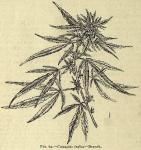112. Cannabis.—Indian Cannabis. Indian Hemp. Hemp.
 The dried flowering tops of the pistillate plant of Can'nabis sati'va Linné or of the variety indica, Lamarck (Fam. Moraceae), freed from thicker stems and large foliage leaves, and without admixture of more than 10 per cent. of fruits.
The dried flowering tops of the pistillate plant of Can'nabis sati'va Linné or of the variety indica, Lamarck (Fam. Moraceae), freed from thicker stems and large foliage leaves, and without admixture of more than 10 per cent. of fruits.
TEST.—When made into a fl'ext. and assayed biologically, produces incoordination when administered to dogs in a dose of not more than 0.03 mil of fl'ext. per kilogramme of body weight.
BOTANICAL CHARACTERISTICS.—Stem 4 to 8 feet high, annual, tall, and roughish, the inner bark consisting of tough fibers. Leaves palmately 5- to 7-divided, the leaflets coarsely serrate. Flowers dioecious green, in compound, axillary racemes or panicles. Akene globose, crustaceous.
SOURCE.—The plant is indigenous to Asia, from India northward to Western China and Caspian Sea. Its cultivation has extended to Central and Southern Europe, Russia, Brazil, and the Western United States— in fact, it may be said to grow in all civilized countries on the globe.
DESCRIPTION OF DRUG.—Cannabis indica occurs in commerce as bundles of the flowering tops; the branches, digitate leaves, and the numerous flower-bracts are more or less compressed, and agglutinated together with a resinous exudation; color brownish-green; odor peculiar, narcotic; taste bitterish, somewhat acrid. It is sold in Indian bazaars for smoking purposes as "gunjah." The leaves, small stalks, and capsules, dried separately and mixed with aromatics and fruits, form the Arabian confection, "hashish, bhang, or siddhi." "Churrus" is a brown, earthy-looking resin, brushed off from the plants by leather-clad men running through the field.
Cannabis americana, the plant grown in various parts of the United States, acts similarly to the official plant. See article by author, "Cultivation of Medicinal Plants in U. S." Jour. Amer. Phar. Assoc., 1915
Powder.—Characteristic elements: See Part iv, Chap. I, B.
CONSTITUENTS.—The resin and a yellow, aromatic volatile oil, C10H16, are its most important constituents. The former, cannabin (15 to 20 per cent.), is a brown, amorphous powder, soluble in absolute alcohol (but not in cold alcohol of 89 to go per cent.), from which solution it is thrown down as a white precipitate by water; it is very potent, 33 of a grain acting as a powerful narcotic; it comes into the market as cannabin tannate; choline, C5H15NO2, syrupy, soluble in alcohol and water, very sensitive to Mayer's reagent, yielding a yellow, crystalline precipitate, is probably the same as the so-called alkaloid, "tetano-cannabinine." Ash, not exceeding 15 per cent.
Cannabinol.—This principle has been obtained by Wood, Spivey, and Ester held from the exudate of cannabis indica (charas). Several different fractional distillates from the ethereal extract of this exudate were obtained. Among these distillates is cannabinol, C18H24O2, boiling at 265°C, It is oleaginous and has a red color. This they have found to largely represent the active principle. A condensed account of the pharmacology of cannabis indica, as contributed by Dr. C. R. Marshall, may be found in "Western Druggist," 1889, pp. 163-166.
Preparation of Cannabin.—Treat drug with water made alkaline with Na2CO3; exhaust dry residue with alcohol; add milk of lime; precipitate with H2SO4; treat filtrate with animal charcoal. From the resulting liquid, concentrated, cannabin is precipitated by water.
ACTION AND USES.—Powerful narcotic. The primary effect of the drug is that of exhilaration, intoxication, stimulating the imagination, etc. This is followed by depression, drowsiness, and stupor, the heart becomes weak and slow and the pupil dilated. It has some advantages over opium, it is claimed, in that it is not constipating, and interferes less with digestion; it is more acceptable in certain morbid states of the system and nervous disquietude. Dose: 3 to 5 gr. (0.2 to 0.3 Gm.).
OFFICIAL PREPARATIONS.
112a. CANNABIS SEMEN.—HEMP SEED. These have been used in the form of emulsion as demulcent and anodyne, depending upon the fixed oil which they contain. They are mostly used as a bird-seed, however, and for the extraction of the fixed oil.
112b. OLEUM CANNABIS.—OIL OF HEMP. A greenish fixed oil, becoming lighter and brownish on exposure; odor hemp like; taste mild. Used as a demulcent and protective. Neither it nor the seed are thought to have any narcotic action.

